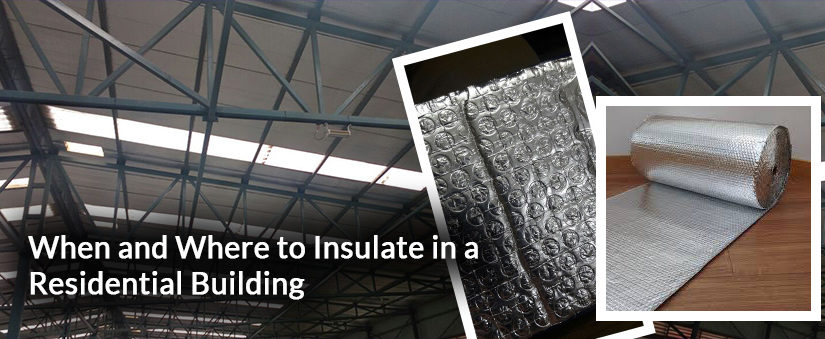Insulation is one of the prime factors that one should consider before constructing a building. When we talk about energy conservation and preservation, it starts with your home. Energy is a strategic commodity and plays a prominent role in a country’s economic development. Thus, it is important to wisely use the national commodity. Moreover, if energy consumption is reduced then there will be cost-saving on utilities like electricity, water, etc. Thermal insulation is the key factor that if implemented successfully can benefit in saving up to 90% of the energy.
Where to insulate in a building?
To start with the thermal insulation of the house or any residential building, it is important to analyze the weak spots in the building that need to be insulated. There are numerous areas from where air can leak or heat transfer can take place.
Few of the areas where possibilities are high for heat transfer is as follows:
- Thermal insulation is required for unfinished attic spaces between and over the floor joists to prevent the escape of the air and heat exchange.
- Insulate between studs of knee walls.
- Insulate space between rafters and studs.
- Providing insulation between roof and ceilings.
- Insulation of exterior walls is more prone to exchange the heat, moisture, and air.
- Floors above unheated garages or floors that are built directly above ground.
- Bend beam, where there is a high chance for escape spaces.
Attic/Loft Insulation
Providing loft or roof insulation ensures high resistance to heat, moisture and sun’s radiation. The type of insulation used for insulating attic is either loose-fill or batt insulation. However, loose-fill insulation is cost-effective and offers better coverage area than batt insulation.
Exterior Wall Insulation
If your house feels warmer in summer or colder in winter then one of the reason is lack of proper exterior wall insulation. For a pre-built home, use blow-in insulation that will provide a significant air sealing and will enhance thermal stability inside your living space. Also, if you are repairing or remodeling your house walls and if, your wall cavity is open then use two-part spray foam to fill the cavity.
However, if you are planning an architectural structure for your new house, then it is advisory to consider thermal insulation contractors. They will help you in deciding the best-suited heat insulation material or thermal insulation material for your house according to the climatic conditions in your surroundings.
The perfect insulation technique which will improve the R-value of the complete wall is advanced wall framing techniques. This technique helps in thermal bridging and enhancing wall insulation area. Use of insulation wall sheets provides higher R-value than wood sheathing. Thus, use higher R-value insulation sheets for better thermal bridging.
Underdeck Roof Insulation
They are the efficient heat barriers and thus ideal for providing heat insulation in buildings. The underdeck insulation materials for roofs provides resistance to UV rays penetration. Apart from this, it reduces unwanted noise entrance and heat escape.
There are many types of underdeck roof insulation materials like TF Expanded Polystyrene, Phenotherm, Aluminum Faced Fiberglass, Polynum or Crosslinked Polyethylene.
Color Coated Roofing Sheets
Well, another type of insulation for the open space in the roof can be insulated by color coated insulation sheets. These sheets come in different colors like grey, blue, green, red, etc. each color has a specific significance in preventing the entrance of harmful UV rays and wind from the roof. Apart from this, it stops dust to enter your clean living space. If you are living in areas with hot weather and little dust then you can implement color coated sheets. Also, it will add to the beauty of the house.
Basement Insulation
Basement is connected to a major part of your living space. The ceiling which becomes the floor of your living space and the exterior walls of the basement which is highly susceptible to the underground soil, moisture and water content can cause a major defect in the thermal stability of your house.
Thus, to insulate better you basement it is advised to build a strong foundation of the house by minimizing the thermal bridging, providing resistance to moisture intrusion, reduce condensation on the surfaces, etc.
Depending on various geographical conditions and constructional requirements, your insulation contractors will suggest the best type of insulation material. Following are the types of insulation materials that enhance the thermal stability of your building.
– Foam board insulation
– Loose-fill insulation
– Blanket insulation
– Sprayed foam insulation
What is the best time to insulate your residential building?
The best and highly recommended time to install insulation whether heat insulation, underdeck roof insulation or ceiling insulation, etc. is when you are constructing the building or while renovating the building.
To meet the minimum energy efficiency standards it is preferred to build a house by following the standards as stated by the legal department of the states or territories. However, it is never too late to insulate your existing building as there are many options to do the insulation of your already constructed building.
Conclusion
Insulating your building brings a significant cost-cutting in your electricity bills while making your living space comfortable and cozy. Today, there are many cost-effective insulation materials are available that are eco-friendly and offers high durability with less maintenance. Try to consult an expert from a top provider of insulation services and get the best-suited insulation advice.

